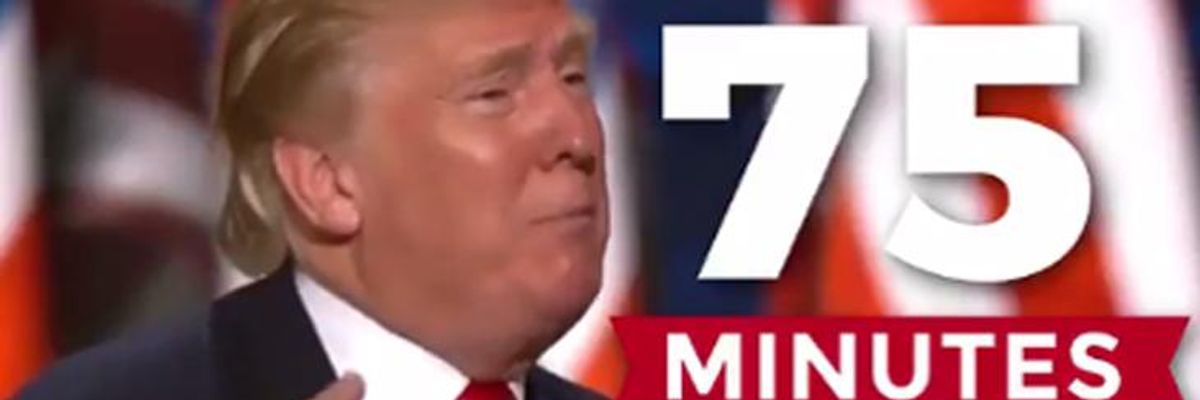Do what thy manhood bid thee do,
From none but self expect applause.
-- Sir Richard Francis Burton
An ad that was run by the Trump campaign hours after the Republican convention ended answers a question that those of us who have watched speeches given by Mr. Trump have asked ourselves. The question is posed by the way in which Mr. Trump makes his appearance when coming on stage before giving a speech. There are, of course, countless ways that a person preparing to give a speech can come onto the stage.
Someone who is preparing to make an important speech about a substantive matter is often seated on the stage next to the person who is going to introduce the speaker. When the introduction is completed the speaker, and the person who has made the introduction shake hands or briefly hug, and the speaker, as expected, speaks.
In a more raucous setting such as Saturday Night Live or one of the late night television shows, the moderator announces the name of the next guest with great enthusiasm, and the guest comes running out onto the stage from the back, waves eagerly at the crowd, and enthusiastically shakes hands with the moderator before beginning to perform. (Sometimes the hand shaking occurs only after the guest has done whatever it was he or she was invited to do.)
The politician who attends a campaign event in which a speech is to be made, ordinarily passes by a throng of admirers arranged behind the podium, shakes hands and poses for selfies with that group, and waves enthusiastically to those in front of the podium, making eye contact with and smiling amicably at a few familiar faces the candidate spots in the crowd in order to let them know they have been recognized by the speaker. That is done in order to give the recipient of the smile a warm feeling, and inspires him or her to write another check to the candidate's campaign.
Those are not the only ways in which speakers make their appearance before an audience they intend to address. Mr. Trump has introduced us to another. Frequently, when Mr. Trump appears in the kinds of settings described above, he engages extensively in self-applause. It is not so vigorous as to be audible but is a gesture of self-satisfaction and self-approval. Many of my readers may be unfamiliar with the term "self-applause" and it can best be understood by referring to synonyms for that word that are found on line. They include "pretentious, bombastic, cocky, pompous, arrogant, conceited, egotistical, know-it-all, puffed-up, snooty, vain glorious, full of hot air and swollen-headed." Any one of those words is a perfect description of Mr. Trump. (For those who like to define words by referring to their antonyms, some of the antonyms that come up when searching the internet include "humble, modest, and self-deprecating." None of those words comes to mind when considering Donald Trump.)
Although the act of self-applauding affords an excellent description of Mr. Trump when he appears before a crowd, the question remains why he finds it necessary to applaud himself instead of using the time dedicated to self-applause to shaking hands and waving at supporters as others in his position normally do. The answer is that he believes that applause is the most important part of an appearance, even if the applause comes in part from himself. Nothing shows the value he places on applause better that an ad he ran immediately after the Republican convention. The ad ran for 45 seconds and was simple, but effective, as any of my readers who takes the time to look at it, will agree.
There was no narrative in the ad. It starts with a picture of Mr. Trump with his mouth open and his thumb and first or second finger touching, to form an "O" that mirrors his open mouth. (The use of the thumb and forefinger touching is a typical gesture made by Mr. Trump when speaking and helps him emphasize the importance of what he is saying.) Following the opening picture of Mr. Trump, the first words to appear are "75 MINUTES Total Speech Time," accompanied by an image of Mr. Trump talking, followed a few seconds later by images of an enthusiastic convention crowd over which the words "24 MINUTES total applause," appear and then a few seconds later, the words "33% Time Spent Applauding." (The ad first appeared only a couple of hours after the speech had been given, and there was not time for the mathematicians on Mr. Trump's staff to check the time spent applauding which was, in fact, only 32% and not 33%. That, however, does not take away from the effectiveness of the ad.) None of the images accompanying the ad shows Mr. Trump self-applauding and it is safe to assume the time he spent doing that was not included in the calculation of total applause time since were it otherwise, the numbers would almost certainly be very different. (His words are usually preceded by long periods during which he acknowledges the adulation of his audience by self-applauding.) At first blush it seems odd that Mr. Trump would place more importance on the minutes devoted to applause than to the substance of his speech. Upon considering the substance of his speech, however, it makes perfect sense.
